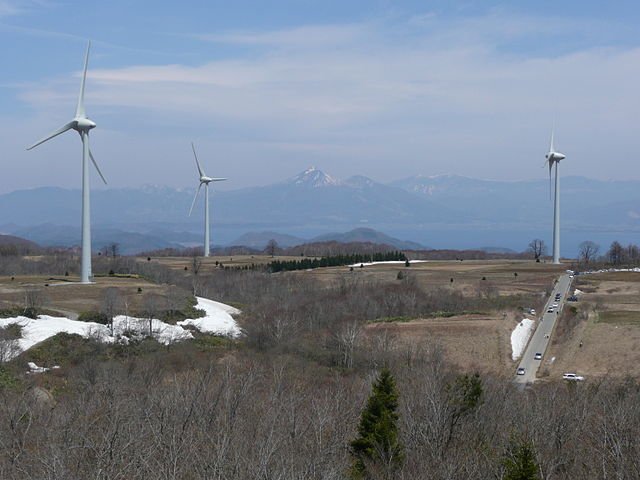Japan is a major consumer of energy, ranking fifth in the world by primary energy use.
Fossil fuels accounted for 88% of Japan's primary energy in 2019.
Japan imports most of its energy due to scarce domestic resources.
As of 2022, the country imports 97% of its oil and is the larger LNG importer globally.
Electricity pylons in Japan
A self-service Eneos gas station in Ebina, Kanagawa
The 2011 Fukushima Daiichi nuclear disaster, the worst nuclear accident in 25 years, displaced 50,000 households after radioactive isotopes were dispersed into the air, soil and sea. Radiation checks led to bans of some shipments of vegetables and fish.
Turbines at the Nunobiki Plateau Wind Farm, one of the largest wind farms in Japan with 33 turbines
Prior to the 2011 Tōhoku earthquake and tsunami, Japan had generated 30% of its electrical power from nuclear reactors and planned to increase that share to 40%. Nuclear power energy was a national strategic priority in Japan.
As of March 2020, of the 54 nuclear reactors in Japan, there were 42 operable reactors but only 9 reactors in 5 power plants were actually operating. A total of 24 reactors are scheduled for decommissioning or are in the process of being decommissioned. Others are in the process of being reactivated, or are undergoing modifications aimed to improve resiliency against natural disasters; Japan's 2030 energy goals posit that at least 33 will be reactivated by a later date.
The Onagawa Nuclear Power Plant, a 3-unit BWR site typical of Japan's nuclear plants.
The Kashiwazaki-Kariwa Nuclear Power Plant, a nuclear plant with seven units, the largest single nuclear power station in the world, was completely shut down for 21 months following an earthquake in 2007.
The 2011 Fukushima Daiichi nuclear disaster, the world's worst nuclear accident since the 1986 Chernobyl disaster, displaced 50,000 households after radioactivity leaked into the air, soil, and sea. Radiation checks led to bans on some shipments of vegetables and fish.
The Ikata Nuclear Power Plant.







